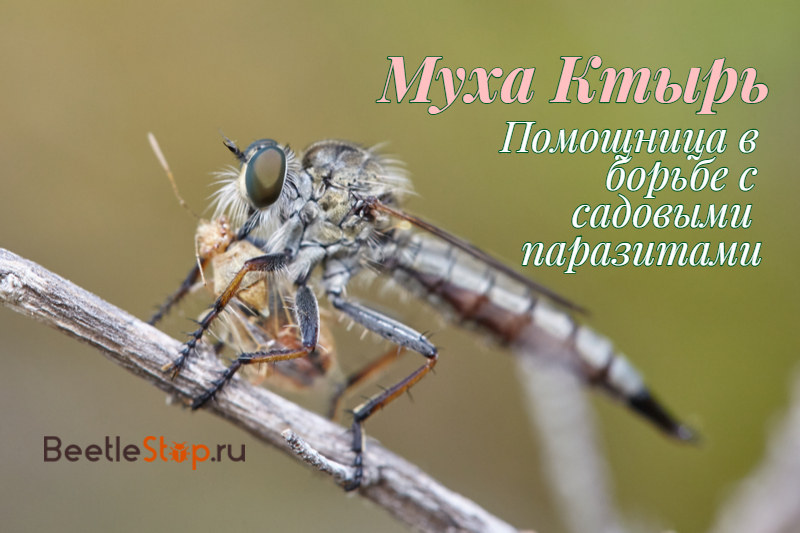Merciless Insect Killer - Poison Fly
A detachment of dipterans is surprised by the diversity of representatives. A close relative of the common fly is the kytr, a ruthless hunter for small and medium insects. A strong body, strong limbs with spikes, stiff proboscis and poison - all this nature armed the predator. The fly is found all over the world, excluding Antarctica. Fighter annoying insects provides a great service to people. But the widespread use of insecticides threatens the existence of beneficial species, some are in the Red Book.

Description
Ktyr is a large family that united winged predators. The genus Asilidae belongs to the order Diptera, suborder Korotkousy. The Kıtır family dates back to the Mesozoic era, in our time it has more than 7,000 species. A characteristic feature of the structure of the imago is a massive mid-chest and an elongated abdomen. The shape of the body depends on the species, but in any case it is elongated, cylindrical. Insects living in a temperate climate reach a length of 3-50 mm, representatives of tropical species grow up to 80 mm.
The color of the predator is most often black, there are species with brown, reddish or red sclerites. The body is covered with gray pollen, some individuals have a pattern of light stripes and spots. The head is large, almost spherical in shape. Most of its lateral surface is occupied by complex faceted eyes. The forehead is pressed into the crown of the head with three simple eyes. The antennae are shortened. Bristles, called a beard, grow in the lower part of the face. They cover the proboscis. This structure allows you to protect the body from damage if the victim will fight back.
Interesting fact. The head and chest are connected by a movable neck. Some insects can turn their heads 90 °.
Strong, well-developed midbrain muscles provide powerful flight and the ability to capture prey with limbs. In most species, this part of the body is covered with bristles, hairs and pollen. The wings are well developed, their color varies from transparent to red, brownish and black. Legs are long, massive, covered with bristles. The photo shows that the limbs of Ktyr are adapted by nature to capture and hold prey. Males on the front tibia may have a cluster of contrasting black and white hairs.
Lifestyle
The insect killer is known for the habits of an aggressive predator. It feeds on small insects, which it lies in wait and catches on the fly. A fly, called a robber and a murderer, can rarely be found carelessly sitting on a branch. If she is not in flight, she chooses another victim. The predator's diet includes many types of insects:
- flies;
- dragonflies;
- grasshoppers;
- beetles;
- wasps and bees;
- butterflies.
Ktyr prefers dry places, settles in the steppes and meadows. It rarely flies into parks and gardens. Noticing the prey, he rushes after. The insect has no chance to escape from a swift attack. The ktyr kills the victim with the poison. His proboscis hurts like a stylet, and the salivary glands eject a powerful poison that instantly kills prey. It contains substances that break down the insides.
It remains for the predator to suck out a nutritious cocktail with its proboscis. Big eyes are also indispensable when looking for food and observing enemies. Predatory birds are divided into several groups depending on the places of hunting.They are found everywhere - above the ground, in the grass, over the grass, in the trees.
Attention. Captured cattle are very aggressive and can bite a person. The injection of his proboscis is comparable to the sting of a bee.
Breeding
After fertilization, females lay light eggs up to 2 mm in size. Species laying in the soil have spikes and bristles on the ovipositor. Females place eggs in various places - on low plants, in cracks in the bark, and in soil cracks. On top of the masonry is covered with special powdery secretions. Larva of white or yellowish color, elongated. In the front of the body of the mandible (jaw) in the form of hooks. The larva develops in the soil, feeds on rotting organic matter. Here she pupates.
Giant Ktyr
One of the largest species of the family is called giant ktyr or Satanasgigas. The genus of predatory flies with the eloquent name "Satan" includes insects exceeding 50 mm in size. The length of the giant, despite the name, is rather modest 28-51 mm. The body is covered with gray plaque, proboscis shorter than the head. Larvae develop in the soil, this stage lasts about a year.
Satanasgigas inhabits deserts and semi-deserts in northern Africa, Mongolia, Central Asia, Kazakhstan, and southern Europe. His presence is noted in Ukraine, Russia, Greece. The giant ktyr was once included in the Red Book of the USSR, now the insect is protected only in Ukraine.


 (votes: 3, average rating: 4,33 out of 5)
(votes: 3, average rating: 4,33 out of 5)